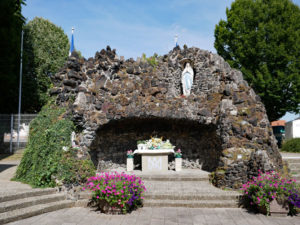Farébersviller St-Jean-Baptiste




























































































Église St-Jean-Baptiste Farébersviller
Where to find this church
Church Information
Église St-Jean-Baptiste is located in Farébersviller, a town in the Département Moselle in France, about 5 miles south of the Franco-German border, and 15 miles south-west of the German City of Saarbrücken.
This church is locked
* denotes external links that open in a new window




Visiting Farébersviller St-Jean-Baptiste
The church of St-Jean-Baptiste in Farébersviller is normally locked. In 2008, when I organised a two-day tour of Round Tower Churches in Saarland and Alsace-Lorraine for a group of members of the English Round Tower Churches Society, I had approached the mayor Laurent Kleinhentz (who is still in office, by the way!) and asked if he could arrange for the church to be opened for us. And this on a Sunday morning, because it fitted into our schedule. Well, what we then experienced was certainly the highlight of this tour: he received us personally together with the sexton, and not only showed us the whole church including the tower and the attic, but also provided us with tons of information about Farébersviller and the church, including various copies of a book he had written himself, and copies of old photos and drawings of the church, which you can now see in the slide show above.
The following text, which describes the eventful history of the church, was written by him: There is not much left of the beautiful Romanesque tower the village was so proud about until the end of WW ll. The fights during the liberation and even more vandalism have defaced this witness of 800 years of history. Two historians, H. Gerlinger and H. Collin, have examined the tower, and have compiled a lot of useful material to understand the context in which the round towers of the region were built. But the late date of their work, 1957 and 1981, which was based mainly on a closer examination of the masonry and less on printed sources encouraged us to resume the examination of the history of this building. The parochial and communal archives of the 18th and 19th century — although quite substantial — do not tell us a lot specific about the tower. It seems that no major works were carried out in these times. The records of the canonical visits of 1698 mention a tower “en etat” — meaning in a “normal” state and 1751 “clocher solide et bien couvert” — meaning a “solid and well covered” tower. In 1926, the slate of the church spire was replaced, together with the ball at the base on the top and the weathercock. The battles of 1944 caused major breaks in the upper part of the tower, while the slate and the old oak frames of the roof were perforated by shell splinters. Photos from this time show that these damages were far from irreparable, but those in charge locally decided otherwise. 1945, the spire was thrown down, and the upper floor of the tower was demolished. The reconstruction of the tower in 1956/57 lead to a defacement of the remains of the tower (modern plaster, destruction of the old vault door to let the bells pass through). This was in clear contrast to the opinion of the board of the conservation of monuments. Fortunately, there are still records of the measures of the Abbé Toura and the Curé Paris between 1920 and 1927, and also photos before the tower was destroyed, and contemporary witnesses, to complete the articles of the aforementioned historians. H. Collin describes the tower as late 12th century, and counts this tower among the round towers of the region whereas the reason for their existence is still unclear. In 1927, the priest Paris described the building as follows: “Round at the base and in its lower part, while the upper part is octagonal. The walls are one meter thick. At the base, the inner diameter is 3,30 m. Its height up to the base of the spire is 15 m, while the spire itself is 10 m high. The crucifix on top of the tower is 3 m high.” Other reliable sources mention an overall height of 27 m without the crucifix. The original tower had three doors. The one which allowed to enter from the outside had a width of 1 m and a height of less than 2 m. Its beautiful vaulted arch was replaced with a rectangular opening in 1957. A second door allowed entrance into the nave from the tower. This was originally the only entrance into the fortified church until 1758 when a new nave with a large entrance was built. The door was bricked up, and restored in 1992 when major renovation works took place. A third door above the ground allows entry into the attic of the nave. In addition to the three doors, two hatches and three minor loop-holes can be found, underlining the original fortress character of the original building. The ancient upper part of the tower has openings in all four points of the compass to allow spreading of the sound of the bells. Inside the tower, two wooden platforms which are linked with simple ladders allow to reach the floor of the turret clock and the bells.
The current nave, built in 1758/59 and widened during the Second Empire, replaced an old building about which no records exist (dimensions, number of windows…). The only certainty is that the size of the original building reflected the demographics of the Middle Ages, which did not correspond to the growing number of inhabitants in the 18th century. During the demolition of the original nave holy relics came to light which were hidden in the old altars, which were consecrated by Reginald, the 68th bishop of Metz in 1302. Vicar Nitzel who reported the facts how these relics were brought into the new main altar “under an ordinary stone in a covered tin pot in the form of a coffer laid out with red silk”; theoretically, they should still be there… Concerning “Reginald” (Renaud de Bar, bishop of Metz 1302 till 1316): did he really come in the first year of his episcopacy to consecrate the altar of this church? If so, the church must have been completed just before this date, and perhaps, chronologically this was the second nave attached to the round tower of the 12th century. The destruction of the old altars in 1758 robbed us the evidence which might have proven this point.
Conclusion: locked church with an eventful history




